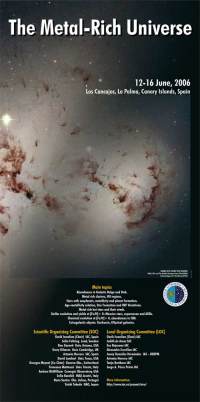General Information
The conference is organized by the Instituto de Astrofísica de Canarias (IAC) and will be held from 12-16 June, 2006 at Hotel H10 Taburiente Playa, Los Cancajos, La Palma, Canary Islands, Spain. See a static map of La Palma or in Google Maps. The Second Announcement with full information is available in PDF format.
Results of the questionnaire (PDF)Scientific Rationale
The metal-rich Universe can shed new lights on very topical subjects, extending and complementing our knowledge of the physical processes that are more commonly studied at solar and low metallicities. Among those processes and problems we may cite the following ones:
- What is the highest [Fe/H] attained?.
- What are the abundance trends and dispersions of abundance ratios in the metal-rich Galactic bulge and thin disk?.
- What is the nature of Super Metal Rich (SMR) stars and what do they imply about early Galactic chemical evolution (age-metallicity relation)?. What do they teach about metallicity-dependent nucleosynthesis yields?. How does the observed Galactic radial metallicity gradient in the disk constrain the radial flow origin of SMR stars?.
- What is the effect of high metallicity on star formation? Does the initial mass function vary at high metallicities?.
- It is now well established that stars rich in metals are more likely to harbor planets. Does this mean that there is a minimum metallicity for planets to form around stars?
- What is the effect of high metallicity on stellar evolution?. One can expect that the most massive stars lose more mass through radiatively driven stellar winds. How does it affect stellar rotation, stellar parameters and evolutionary tracks?.
- What are the consequences on the stellar populations expected and on the chemical enrichment of the interstellar medium?.
- As the number of extrasolar planets has grown - more than 140 stars are now known to have planets, this has triggered careful and detailed abundance studies of more and more metal-rich stars. Trends of the abundances of many element at high metallicity are now available and wait for an interpretation in terms of stellar nucleosynthesis and chemical evolution models. Are the observed trends in agreement with the predictions of current stellar and chemical evolution models?.
- Is the center of the Galaxy metal rich?. The good adequacy of the models in the high metallicity regime is of great interest for the study of the central regions of galaxies, some thought to have higher than solar metallicity. The question of the metallicity of the central region of our own galaxy and its stellar content will be addressed in this context. Also it appears that many quasar environments are metal-rich out to redshifts of at least 5. Low-resolution, integrated-light, spectra of giant elliptical galaxies imply a mean metallicity of some objects equal to, or greater than, the most metal-rich stars in the Galaxy. Is this real, and if so, how can it have occurred? A better knowledge of star formation and evolution in high metallicity regions appear thus as a key element to progress in these areas of research.
Whereas several conferences on metal poor stars have been organized in the last few years, none on metal rich stars has been held in spite of recent progresses in the field. In this conference the different aspects related to the above issues will be addressed. More specifically, the latest observations of metal rich stars (in the field, clusters, bulge, planet hosts etc.) will be presented. On the theoretical side, models atmospheres and spectral line formation, models of star formation and stellar evolution nucleosynthesis at high [Fe/H] will be discussed and uncertainties examined.
Main topics
- Abundances in Galactic Bulge and Disk.
- Metal rich clusters, HII regions.
- Stars with exoplanets, metallicity and planet formation.
- Age-metallicity relation, Star Formation and IMF Variations.
- Metal rich hot stars and their winds.
- Stellar evolution and yields at [Fe/H] > 0: Massive stars, supernovae and AGBs.
- Chemical evolution at [Fe/H] > 0, abundances in ISM.
- Extragalactic objects: Starbursts, Elliptical galaxies.
Meeting Schedule and Format
Scientific sessions will take place from Monday, June 12th, through Friday, June 16th, with a maximum of 150 participants. The format of the conference will be organized with a total of 8 sessions of 4 hours each. Invited Reviews of 30 minutes including discussion and Contributed Talks of 20 minutes. Poster presentations will be exposed during the whole meeting.
Conference Venue and Facilities
The conference will take place at the conference centre of the Hotel H10 Taburiente Playa, where the participants are accommodated. This hotel has full facilities for conference users including:
- A large conference hall.
- A small computing centre with high-speed links. This will provided by the IAC for the conference and will be available during conference hours only.
- Ample poster area for poster exhibitions. Individual panels (1m x 1m) will be provided.
- Overhead and multimedia projectors, and computer display facilities for your laptop.
- Coffee-breaks will be held outside the conference hall.
Sponsors
Financial support is provided by the IAC. Additional support has been provided by the Excmo. Cabildo Insular de La Palma (La Palma local government), the Patronato de Turismo de La Palma (La Palma tourist board), DISA Corporación Petrolífera, S.A., and the Banco Bilbao Vizcaya Argentaria (BBVA).
